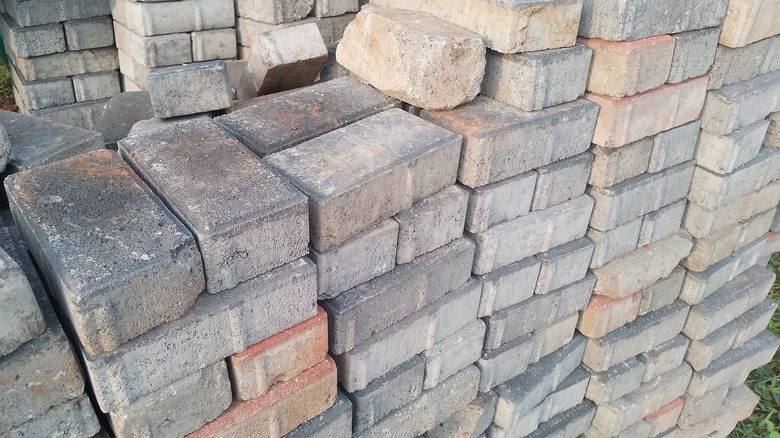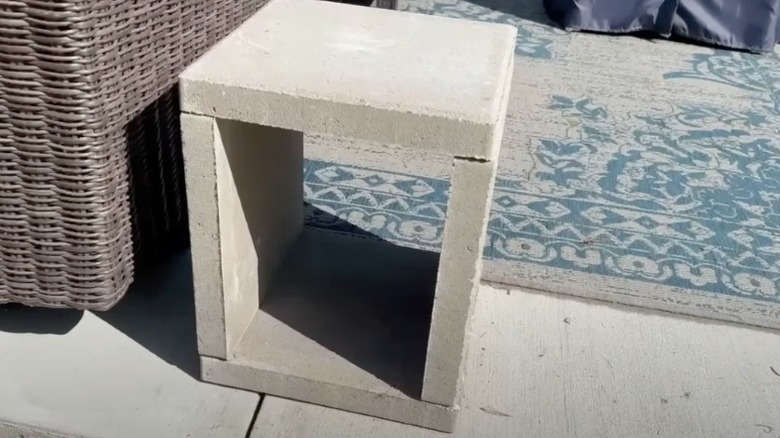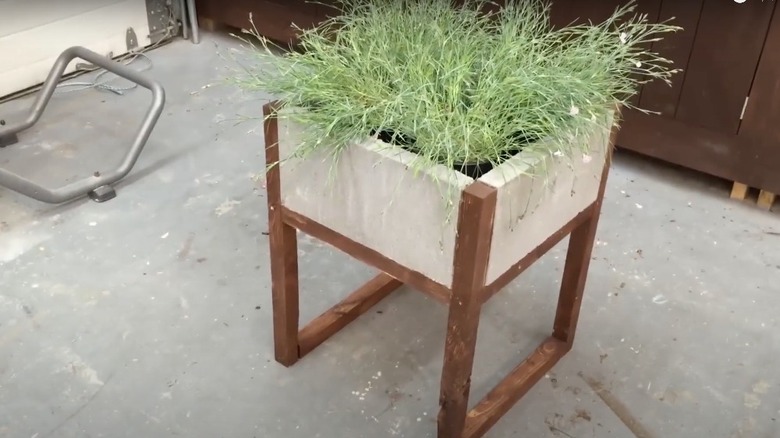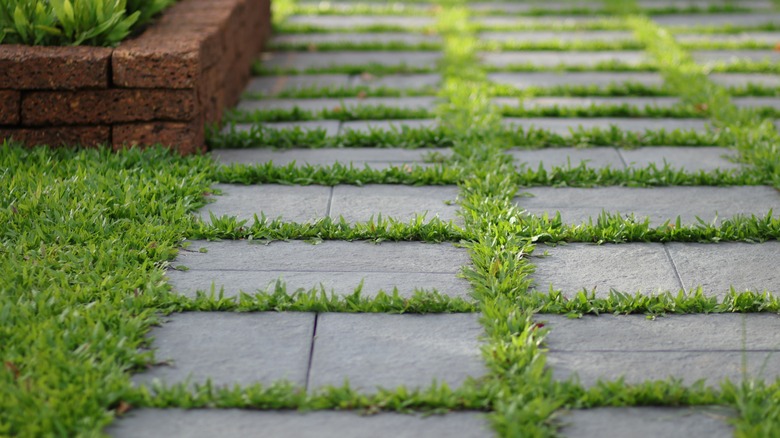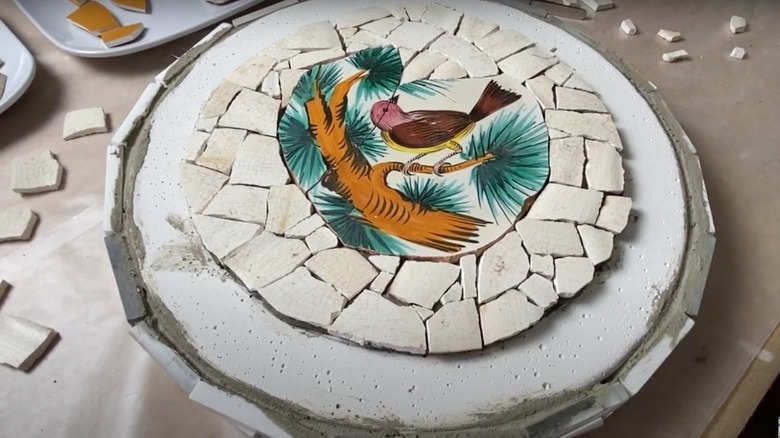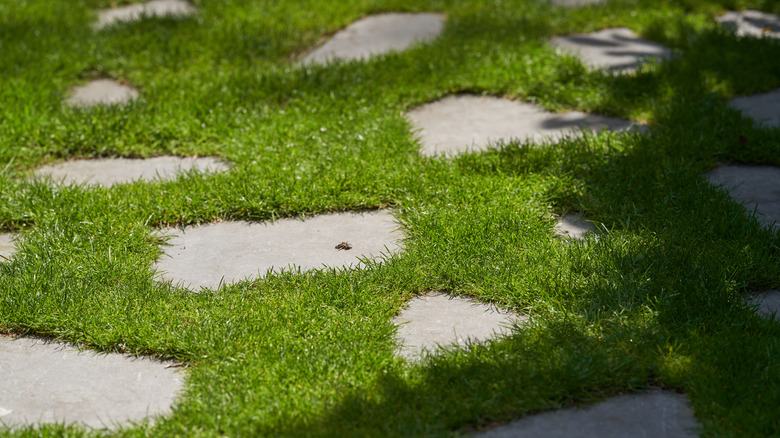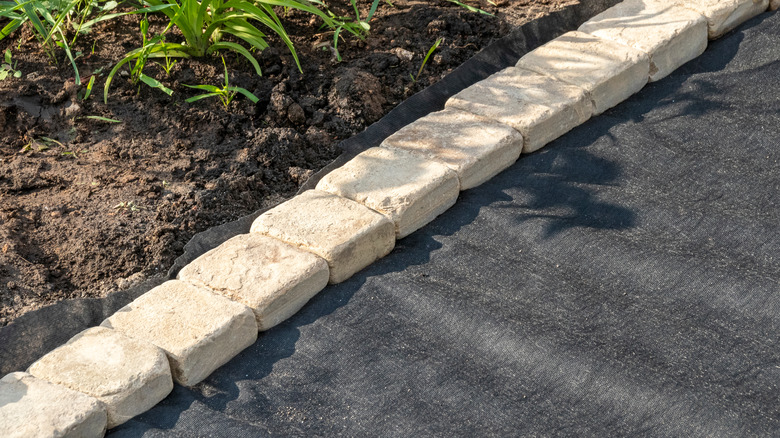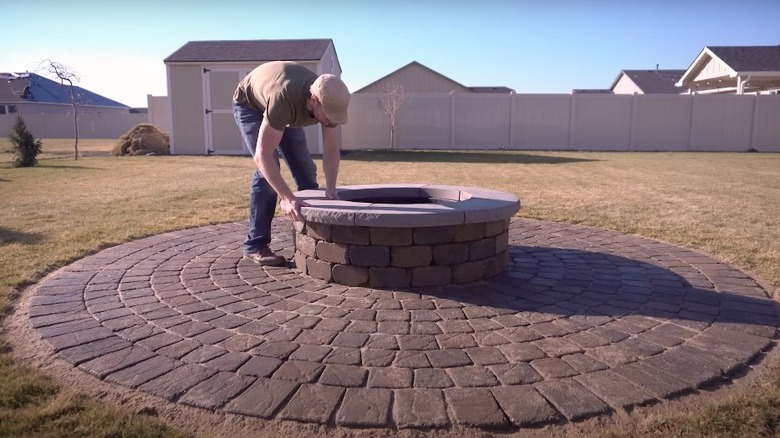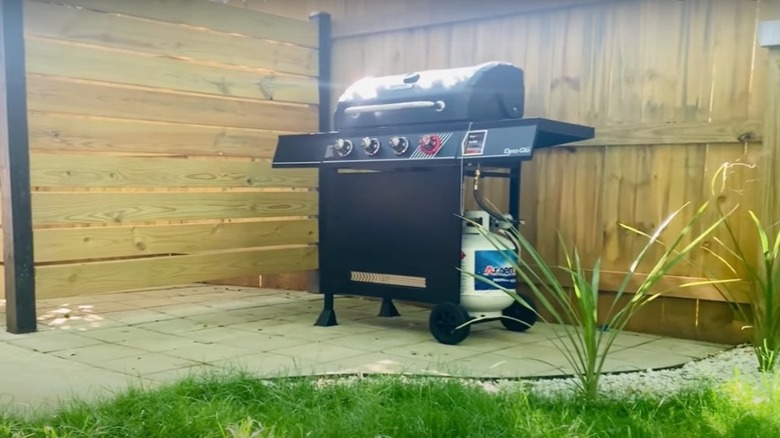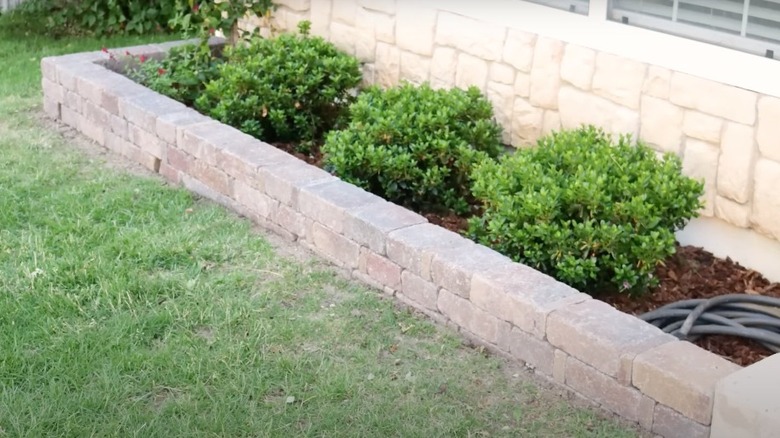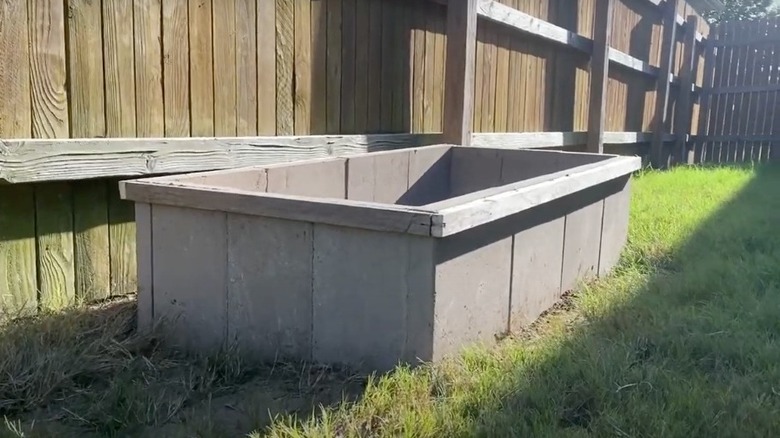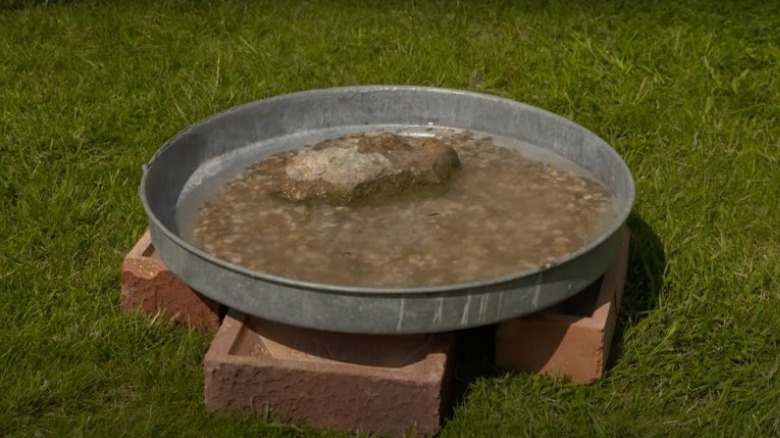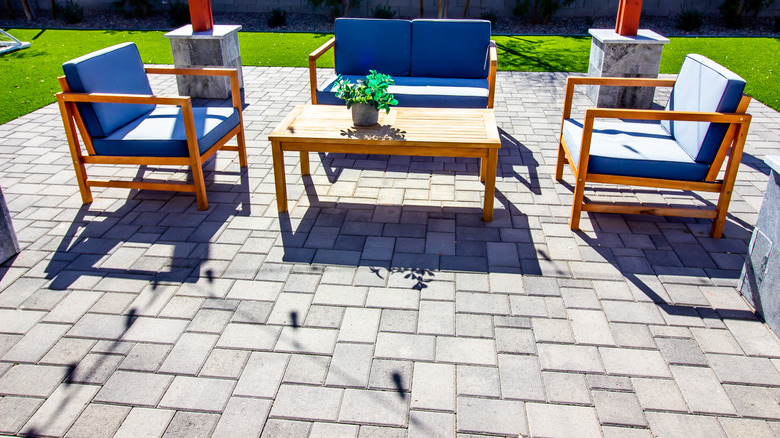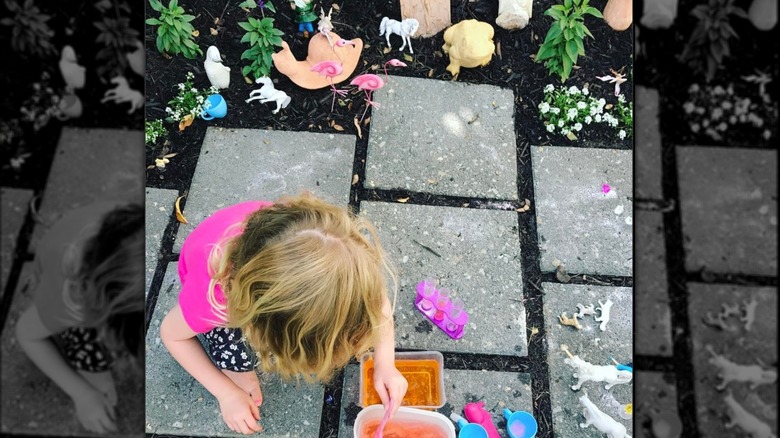13 Unique Ways To Repurpose Old Pavers In Your Yard And Garden
Did you know that concrete pavers are one of the strongest building materials available? This incredible strength comes from concrete's unique chemical makeup, along with ASTM standards requiring all concrete pavers in the US to provide at least 8,000 psi. The term PSI stands for 'pounds per square inch.' Essentially, this means concrete pavers with 8,000 psi and up are at least two times stronger than a standard slab driveway! This makes them an excellent addition to not only building projects but also many kinds of DIY endeavors, ranging from building a raised garden bed to sleek and stylish hardscape edging.
So, do you have a stack of old pavers taking up room in your shed that you don't know what to do with? Before throwing them away, consider repurposing the pavers for another use in your backyard or garden. Even novice crafters can turn pavers into something completely new, from quirky garden tables to a winding stepping stone path that can stand up against extremely harsh conditions. Most of these repurposing projects require just a few materials and a bit of time to bring the pavers back to life in a new, eco-friendly way. So, if you're ready to get DIYing, here are 13 ways you can put those old pavers to good use.
1. Build a small garden table
Did you know you can use an old patio paver to craft your own furniture? Yes, you really can use pavers to DIY a garden table that you can proudly display in your yard. While it may sound like a bit of an intimidating project at first, it only requires three materials and a bit of time. If you have patio pavers, concrete edging, and industrial-strength glue, you're ready to get started. One of the biggest advantages of this repurposing project is the ability to customize the finish with a fun color or mosaic pattern.
2. Create a custom planter
Don't rush to the local hardware store for new planters if you've got a few pavers lying around. Instead, DIY the pavers into a custom planter with designs that match your unique style. You'll need a drill to create drainage and glue to hold the pavers together, but the actual process is simple for beginners to complete. Depending on the type of look you want to achieve with the planters, you can spray paint them or keep the bare concrete finish for a rustic approach.
3. Design a garden pathway
Garden pathways are not only practical for navigating through different sections of a backyard but also add a cozy ambiance to the space. One benefit to repurposing old pavers for a garden pathway is that you can save on material costs for the project while adding your personal touch to the final product. You can even use mismatched pavers in different colors or finishes to make the pathway look exceptionally unique. There's also room for customization in the course itself, whether it consists of straight lines or a funky winding path.
4. Decorative mosaic artwork
One repurposing hack for garden pavers is creating a decorative mosaic artwork piece for your outdoor space. There are so many options when it comes to this creative art form, as it allows you to place the mosaic design on whole pavers themselves for the ultimate eco-friendly DIY project. You can build the mosaic pattern on garden items, like stepping stone pavers, as a way to add some color to your backyard and a touch of artistic flair. Be sure to choose colors that match your yard's design to keep things cohesive.
5. Quaint stepping stones
Don't want to commit to building an entire garden path or only have a few pavers? Set up a few stepping stones in your yard. There are no rules when it comes to placing stepping stones, though you should consider the distance between each stone compared to your goals for the space. Are these stepping stones for visual appeal or functionality? They should be close together for walking, but they can be placed more sporadically if it's just for aesthetics. Let your inner style shine when placing the pavers!
6. Lawn or flower bed edging
Looking for a way to elevate your landscaping design? You can use nearly any type of paver, including concrete, stone, or even brick, to edge your flower beds and add clean lines to your yard. Beyond the improved look paver edging will provide, it's also a great way to protect your investments, whether that be hardscaping or garden elements. Having a secure paver edging around flower beds can keep dirt and mulch securely in place, while lining your walkways with it can help with overall durability and longevity.
7. Cozy fire pit area
Add a little pizzazz to your backyard with a paver platform for your fire pit area! There's nothing wrong with having your fire pit directly on grass, but there's always a small risk of damage that could occur from the high heat, leaving an imprint on the space. Instead, use old pavers to create a flat, level space where your fire pit can sit. Depending on how many extra pavers you have, you can also make the area considerably larger than the fire pit to have space for chairs and tables.
8. Flat area for grilling
Backyards with hills and uneven terrain can be a nightmare when it comes to grilling for family and friends. Having your grill sit slanted is not only an eyesore, but it can also lead to issues with heat distribution and uneven cooking. Some grills have even been known to fall over and cause a fire when placed on a hill. Pavers are an excellent way to create a level slab that's safe for grilling, but be sure to place it at least 10 feet from any structures.
9. Build a garden wall
Garden walls are an excellent way to add some depth and privacy to your backyard. You might use this landscaping technique to separate different sections of your garden or just to add eye-catching elements to the greenery. Whatever your reason for DIYing a retaining wall, it requires an eye for detail. For example, it's important that your trench and first level of pavers are level and you take your time. Working slowly and building a solid structure will ensure your wall looks great and stands the test of time.
10. Construct a raised garden bed
Take your backyard to the next level by repurposing old pavers into a raised garden bed. Traditional in-ground plants certainly have their place, but there are numerous benefits to choosing raised beds instead. One of the most prominent advantages is that they are easy to maintain, as they don't require you to bend over as far or get onto the ground. Raised beds are also known to be productive thanks to the drainage and soil conditions. There are commercial garden bed kits available for sale, but using materials you already own is an eco-friendly choice.
11. Designated bird bath area
Setting up a bird bath can be challenging if your backyard is uneven or contains sections of rough terrain. However, using a large paver or several smaller ones can help to create a stable, sturdy platform for a bird bath, especially bowl-only options. For uneven grass, dig out a level area equal to the size of the paver and use a sand base if necessary. Place the paver into the space and re-check to ensure it's level. Now, you can place a bird bath or other type of yard decoration on this level section of ground.
12. Outside seating space
If your yard is just grass, you can repurpose old pavers to create a paved seating area perfect for hosting or grilling. To get started, determine how large of a space you want the seating area to be and make sure you have enough pavers to cover the space. The next steps include digging out the area and adding base material, like sand or stone. Then, you can lay your pavers and apply edging before sealing for longevity. The most challenging part is cutting pavers to resize them, requiring a grinder or circular saw for precise cuts.
13. Kid-friendly fairy garden
One fun yet outside-the-box way to repurpose old pavers is by creating a kid-friendly fairy garden or even a tiny toad village where the small animals can take refuge under cute house-like structures. All you have to do is lay down pavers in any fashion you'd like before decorating the area with fairy accessories, fun colors, and even tiny buildings to add a fun touch to the space. It will not only add a whimsical aesthetic to your garden but also provide kids with a safe place to play away from rough terrain.
